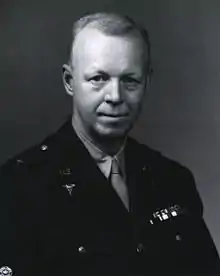Stanhope Bayne-Jones
Stanhope Bayne-Jones (November 6, 1888 – February 20, 1970) was an American physician, bacteriologist, medical historian and a United States Army medical officer with the rank of Brigadier General.
Stanhope Bayne-Jones | |
|---|---|
 | |
| Born | November 6, 1888 New Orleans, Louisiana |
| Died | February 20, 1970 (aged 81) Washington, D.C. |
| Allegiance | |
| Service/ | |
| Years of service | 1915 - 1919, 1942 - 1946 |
| Rank | |
| Service number | 0-170753 |
| Battles/wars | World War I World War II |
| Awards | Distinguished Service Medal Silver Star (3) |
Early years
Bayne-Jones was born on November 6, 1888 in New Orleans, Louisiana[1] as the son of physician. His grandfather Joseph Jones was also a physician and served in the medical department of the Confederate States Army during the American Civil War. In this way, Bayne-Jones was influenced in his future career choice.[1] Bayne-Jones attended the Dixon Academy in Covington, Louisiana and then enrolled the Yale University. He graduated in 1910 with A.B. degree. Subsequently, Bayne-Jones matriculated at the Johns Hopkins School of Medicine in Baltimore, Maryland, receiving his Doctor of Medicine degree in 1914.
He became a teacher and also a researcher in the fields of bacteriology and immunology. Bayne-Jones received a commission of First Lieutenant in the Medical Reserve Corps, U.S. Army on August 7, 1915.
Notes
As a member of the United States Surgeon General's Advisory Committee on Smoking and Health, he had a significant role in the 1964 report linking smoking to cancer.[2]
Bayne-Jones was the subject of a biography in 1992.[3]
Bayne-Jones Community Hospital at the US Army's Fort Polk is named in his honor, as is a professorship at Johns Hopkins University School of Medicine.[2]
His papers were donated to the United States National Library of Medicine in the late 1960s.[4]
Bayne-Jones was the first master of Yale University's Trumbull College from 1932 to 1938.
Decorations
Shown below is the ribbon bar of Bayne-Jones as a Brigadier general:[1][5]
| 1st Row | Army Distinguished Service Medal | |||||||||||||||
|---|---|---|---|---|---|---|---|---|---|---|---|---|---|---|---|---|
| 2nd Row | Silver Star with two Oak Leaf Clusters | World War I Victory Medal with four Battle Clasps | Army of Occupation of Germany Medal | American Campaign Medal | ||||||||||||
| 3rd Row | World War II Victory Medal | Honorary Commander of the Order of the British Empire (United Kingdom) | Military Cross (United Kingdom) | French Croix de Guerre 1914-1918 with Gilt star | ||||||||||||
References
- M.C. Leikind, Bull N Y Acad Med. 1972 April; 48(3): 584–595.
- The Stanhope Bayne-Jones Collection, Repository Guide to the Personal Papers Collections of Alan Mason Chesney Medical Archives Archived 2002-10-22 at the Wayback Machine Johns Hopkins Medical Institutions, accessed January 13, 2013.
- "War and Healing: Stanhope Bayne-Jones and the Maturing of American Medicine", Albert E. Cowdrey, LSU Press, 1992, ISBN 080711717X.
- "Stanhope Bayne-Jones Papers 1852-1969". National Library of Medicine.
- "Valor awards for Stanhope Bayne-Jones". militarytimes.com. 2010-07-04. Retrieved 2013-09-23.